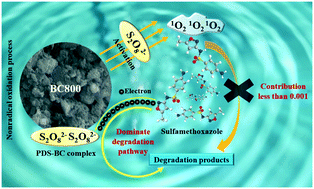Electron transfer mechanism of peroxydisulfate activation by sewage sludge-derived biochar for enhanced degradation of sulfamethoxazole†
Abstract
There is an urgent need for the development of efficient and economical persulfate activators in persulfate-based advanced oxidation processes for wastewater treatment. Accordingly, in this work, sewage sludge from a wastewater treatment plant was carbonized at different pyrolysis temperatures in the range of 400–800 °C via a one-pot synthesis method, which was used to activate peroxydisulfate (PDS) for the degradation of sulfamethoxazole (SMX). Among the samples, biochar pyrolyzed at 800 °C (BC800) showed the best catalytic performance for the removal of SMX (85.3% in 60 min reaction). In the initial pH range of 5.0–11.0, PDS could be activated (0.75 g L−1) efficiently by BC800 for the degradation of SMX. Combined with electron paramagnetic resonance (EPR) spectroscopy, quenching experiment, steady-state kinetics experiment and electrochemical results, the degradation of SMX in the BC800/PDS system was proposed to be a degradation mechanism involving electron transfer as the main pathway. Through the analysis of the intermediates, the possible SMX degradation pathways were predicted. This study provides new insights into the mechanism for the sewage sludge-derived biochar activation of peroxydisulfate and its potential applications for the treatment of SMX wastewater.

- This article is part of the themed collection: Best Papers 2021 - Environmental Science: Water Research & Technology


 Please wait while we load your content...
Please wait while we load your content...